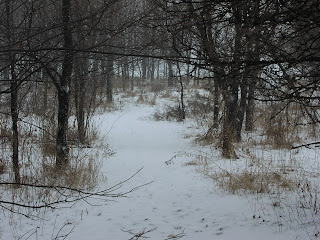Snow by itself is seldom the reason for winter weather damage to trees and plants. Snow often insulates ground plants quite well.
Even heavy snow, such as this one, will generally weigh down pine branches but seldom break them.
Ice is another story. The amount of ice and snow stuck on this porch screen is an indication of the amount on the trees. Not good. Most trees can withstand ice without total damage. Those that are most at risk are fast growing trees, diseased trees, and upward or horizontal branching trees.
Heavy snow on pine bushes provide a warm & wind free shelter for animals and birds. They make an excellent wind breaks for drives and buildings.
Seldom are bushes damaged by heavy snow. Ice may break a few branches but most bushes recover. The only bushes in this area that are prone to heavy damage or death are arborvitaes. This is because they generally have more than one leader coming up from the ground. The weight of the ice and snow will pull at least one leader towards the ground. Seldom can this be fixed.
Wind that accompanies snow and ice is the worst culprit for winter damage. It literally sucks the life from exposed plants. Wind and ice and no snow cover is even worse. Evergreens are particularly susceptible to winter wind damage. A few plants will almost always need winter wind protection; my holly being one. Japanese Maples are another.
Here's a few suggestions:
- Protection from winter elements must be applied before the storm. Wind breaks around susceptible plants, gently tie arborvitaes leaders together, and mulching others.
- Never try to shake or beat ice off trees and bushes. This will cause more damage.
- Don't plant new trees and bushes that are weak or susceptible to winter damage.
- Trim out deciduous tree branches: the dead or diseased, those rubbing against others. Take out entire diseased trees and bushes and replace with winter resistant ones.
- Don't plant large winter susceptible trees near buildings. Consider trimming or removing any tree that could fall on a building and cause personal and building injury.
- Consider letting the power utility take out large trees that could fall on your power lines. It's a free service, they follow national guidelines for tree trimming, they clean up their mess extremely well and I may be prejudiced but they are darn good at what they do.
- There are trees that get extremely large, provide beauty and are not as susceptible to winter weather damage. Research before you landscape.
- Alas, some storms are killers in terms of plant life. These storms are severe to the point that nothing you could have done would have prevented damage. Mourn your loss, clean up the mess and start again. It's all a part of nature's process - even if it makes us sad at the time.
- Check your household insurance coverage to see if or what is covered in your yard. Also, check for the type of weather it will cover. Wind? Hail? Ice? Snow? Flood? Insurance coverage can be tricky and it's good to know. If it doesn't cover that beautiful sixty foot soft maple located fifteen feet from your bedroom - you may want to consider changes (either to the tree or the policy).
- A suggestion I read recently was to photograph your trees and bushes (simple landscape shots of your entire yard) every two years in case you need proof for an insurance claim.
For today - it's another quiet sunny day with nice winter snow cover. But an old saying fits: "Pray for the best and plan for the worst." That's a good idea when it comes to winter storms.
If you'd like to read more, check out my previous articles:
Break Out The Silk Stockings (Article # 1)
Dig It Man (88)
Pondering (99)






weather forecast from Global forecast system
ReplyDeletesnow rain maps
Dear "weather", Interesting overview of Washington and the weather. Glad I don't live in Blizzard Point - just in case it is. Tks. Diane
ReplyDelete